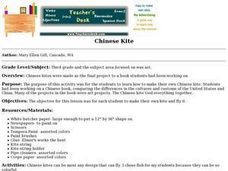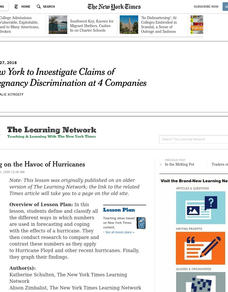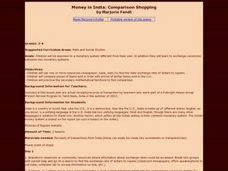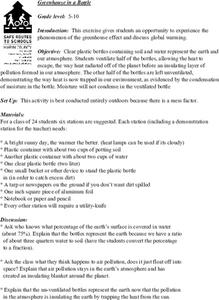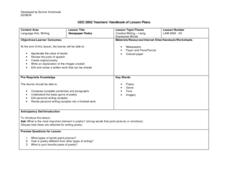Curated OER
Chinese Kite
Students create their own Chinese kite. In this multicultural art instructional activity, students use butcher paper, newspapers, string, pipe cleaners and paint to create a Chinese kite. Students follow the given steps and attempt to...
Curated OER
Getting the News about the Stamp Act
Students review opinions of the Stamp Act as stated in colonial newspaper articles of the 1760's. They compare colonial newspapers to those of today. They take a side regarding the Tax Act and write a note to a friend explaining their...
Curated OER
Bias
Students apply techniques of distinguishing between fact and opinion. Students identify words associated with persuasion and argument. Students read and categorizer a variety of newspapers and articles. Students identfy bias in a...
Curated OER
That Was Then, This is Now
Students read about the effect of strict fur trading laws on the lives of the Inuit people in Canada, then use print and digital resources to compare past and present-day ways of life of several indigenous peoples around the world.
Curated OER
EARLY CIVILIZATIONS
Students compare and contrast the monuments of four ancient cultures and draw conclusions about the origins, construction, and purposes of these structures.
Curated OER
Do They Play Sports in Costa Rica?
Students use the Internet to discover what types of sports the people of Costa Rica play. They write a paper in English but must use at least one Spanish quote. In the paper they compare/contrast sports in Costa Rica and the United States.
Curated OER
Fizzy Pop
Fifth graders compare and identify variables that affect the rate of a chemical change using Alka-Seltzer, water, ice, and hot water. They time how long each variable takes to pop the canister into the air, and record the results on a...
Curated OER
Whose Religion Is It?
Students analyze the impacts of religious expectations on gender roles. In this gender equity lesson, students compare and contrast different religions in societies in order to understand the cultural influences and effects of both...
Curated OER
Large Number Concept
Eighth graders compare objects to large numbers. In this algebra instructional activity, 8th graders compare large numbers to daily objects. Relate large numbers to the real world by discussing the Holocaust and the number of people who...
NASA
Solar Storms
For this solar storms worksheet, learners use an on line source to read newspaper stories about scientific theories and hypothesis related to space weather phenomena. Students answer 7 questions about past solar storms and compare ideas...
Curated OER
Counting on the Havoc of Hurricanes
Learners define and classify all the different ways in which numbers are used in forecasting and coping with the effects of a hurricane. They conduct research to compare and contrast these numbers as they apply to Hurricane Floyd and
Curated OER
A Free and Open Press: Evaluating the Media
Students compare and critically evaluate the different media as sources of news, develop criteria for defining "news", experience the editorial process of selecting news stories and detect bias in news reporting.
Curated OER
Border to Border
Learners use the Internet to gather information on the country of Mexico. They also discover the culture of their people and compare them with the United States population. They take a virtual tour of some of Mexico's most historical ruins.
Curated OER
The Armenian Genocide: The American Ambassador in Constantinople
Students analyze America's reaction to the Armenian Genocide. They write a journal response, read and discuss text, compare/contrast reactions around the world to the Armenian Genocide and the genocide in Rwanda, and write an essay.
Curated OER
Alfred Hitchcock and David O. Selznick
Middle schoolers compare/contrast the Hollywood film industry of the 30s and 40s with Hollywood today. They watch a video on David O. Selznick and Alfred Hitchcock, conduct Internet research, and create a poster to present their findings.
Curated OER
Money in India: Comparison Shopping
Students are exposed to a monetary system different from their own. They learn to exchange currencies between two monetary systems. Practice the necessary mathematical functions to find comparison. Compare prices of items sold in India...
Curated OER
Day-to-Day Life in a Small African Village
Students experience just a bit of what it's like living in a village in Tanzania-from language to geography to health and hygiene issues. They compare aspects of school and home life in the United States with those in Tanzania and...
National First Ladies' Library
All the News That's Fit to Draw: Political Cartooning and the Presidency
Young scholars research, analyze and study the history of political cartooning in the United States. They recognize a political cartoon, be able to identify the main idea, the symbols and the exaggeration and caricature in political...
Curated OER
Depicting Motherhood in Family Stories
Students examine the roles of mothers and grandmothers by looking at black-and-white photographs of one American family and comparing that family's multi-generational story with their own. In this mothers and grandmothers lesson plan,...
Curated OER
Elements of Satire
Students analyze satirical articles. In this elements of satire lesson, students read and analyze satirical articles from newspapers. They create Venn diagrams to compare and contrast articles. Students use calculators...
Curated OER
Weather Observations
Young scholars record the weather using an outdoor thermometer. In this weather instructional activity, students compare their recordings to that on the weather map online. Young scholars explain the differences of each weather reading....
Curated OER
How E-Commerce Influences Consumer Choice
Class members gather information on different brands of athletic shoes to determine which is the best buy. They identify a toy they would like to buy, and gather comparative information from a store, a catalog, and three websites.
Curated OER
Greenhouse in a Bottle
Students create models of the greenhouse effect using recycled 2-liter bottles. They discuss how their models compares to the real greenhouse effect the earth experiences.
Curated OER
Newspaper Poetry
Students cut out nouns, verbs, adjectives, and adverbs from newspapers and create poems using words they have found.
